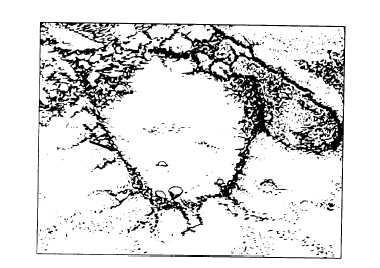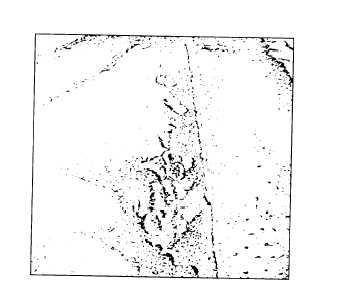subgrade. Upheaval may also be caused by the swelling
effect of moisture on expansive soils.
Disintegration
Disintegration is the breaking up of a pavement into
small, loose fragments. This includes the dislodging of
aggregate particles. If not stopped in its early stages,
disintegration can progress until the pavement requires
complete rebuilding. Potholes and raveling are two of
the more common types of early stage disintegration.
POTHOLES.— Potholes are bowl-shaped holes
of various sizes in the pavement, resulting from
localized disintegration under traffic (fig. 16-21).
They are usually caused by weakness in the pavement,
resulting from too little binder, too thin a surface, too
many fines, or poor drainage.
RAVELING.— Raveling is the progressive loss
of surface material by weathering or traffic abrasion
(fig. 16-22). Usually the fine aggregate wears away
first, leaving little pockmarks in the pavement
surface.
As erosion continues, larger particles
eventually break free, and the pavement soon has the
rough and jagged appearance, typical of surface
erosion.
Raveling is caused by poor construction
methods, inferior aggregates, or poor mix design.
Slippery Surfaces
One of the most common causes of a slippery
flexible pavement is a thin film of water over a smooth
surface. his can cause a vehicle to hydroplane. Other
causes of slippery surface in flexible pavements are
bleeding and polished aggregates.
Figure 16-21.-Pothole.
Figure 16-22.—Raveling.
BLEEDING AGGREGATES.— Bleeding is the
upward movement of bituminous material in a
flexible pavement, resulting in the formation of a film
of bituminous material on the surface (fig. 16-23).
The most common cause of bleeding is too much
asphalt in one or more of the pavement layers. This
is usually the result of a rich plant mix or a prime or
tack coat that is too heavy. Bleeding normally occurs
in hot weather.
POLISHED AGGREGATES.— Polished aggre-
gates are those that have been worn smooth under traffic
(fig. 16-24). Polished aggregates are caused by using
the wrong type of aggregate in the pavement mix.
Figure 16-23.-Bleeding asphalt.
16-20






